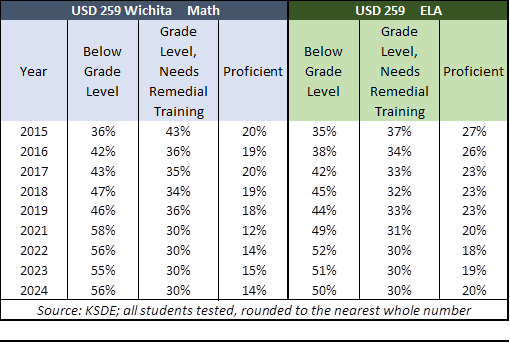The House Appropriations Committee voted last week to increase special education funding next year by $10 million rather than $72 million as planned last year. Predictably, that isn’t sitting well with some legislators but the reduction is appropriate and arguably is within the bounds of what the Kansas Supreme Court declared to be constitutional funding.
According to the Sunflower State Journal, Rep. Jared Ousley (D-Merriam) said the district he serves, USD 512 Shawnee Mission, is shifting $23 million from general education to special education to meet what he called the “funding demands.” That may be what the district told Ousley, but the district’s financial records show the transfer is unnecessary.
USD 512 began the 2020 school year with a $13 million carryover cash balance in the SPED fund. State aid for special education and local transfers exceeded expenditures by nearly $5 million that year, pushing the ending carryover cash reserve to $18 million. Revenue also exceeded expenditures each year since, and the district began this year with more than $41 million in carryover cash reserves.

Unnecessary transfers in prior years mean there probably is no need to transfer anything this year. If SPED expenditures and other revenue change proportionally to prior years, the district would merely return to the $18 million carryover cash balance it had in 2020.
Even that amount is unnecessary, as evidenced by balances held by other large districts and guidance from the Kansas Department of Education.
KSDE Director of Finance Dale Brungardt told me in an email that school districts don’t need an ending balance in a fund like special education to pay bills at the beginning of the year; they need the money somewhere, but it doesn’t have to be in the special education fund to provide special education services.
USD 500 Kansas City, for example, began this school year with zero balance in special education.
Special education is just one of many operating funds that school districts use. Collectively, they had $468 million at the beginning of the 2006 school year, and the total ballooned to $1.3 billion last year. Most of the increase represents state and local tax dollars collected but not spent.

Most school districts have the ability to meet their needs without unnecessarily adding more special education funding.
Special education funding exceeds the constitutional minimum
Education lobbyists argue that SPED is underfunded because a law exists that calls for the state to reimburse schools for 92% of their excess special education costs. However, the settlementreached between the Kansas Supreme Court and the Legislature called for a one-time special education funding increase of $44 million, with $7.5 million added each year thereafter. There is no dispute that that has been done, but education officials still want more…even though they aren’t spending all the money they get.
The Legislature should have repealed the no-longer-relevant special education funding formula, but it didn’t because legislators were effectively bullied to leave it there. They knew that school officials would falsely cry foul, and they didn’t want to deal with the pushback, so they did nothing. Last year, that inaction cost taxpayers about $75 million in extra special education funding; it was an election year, and some legislators would rather waste money than stand up for taxpayers and publicly disagree with the education lobby.
Education administrators and other school officials say it’s all about the kids, but for many of them, it’s all about money and elections.






